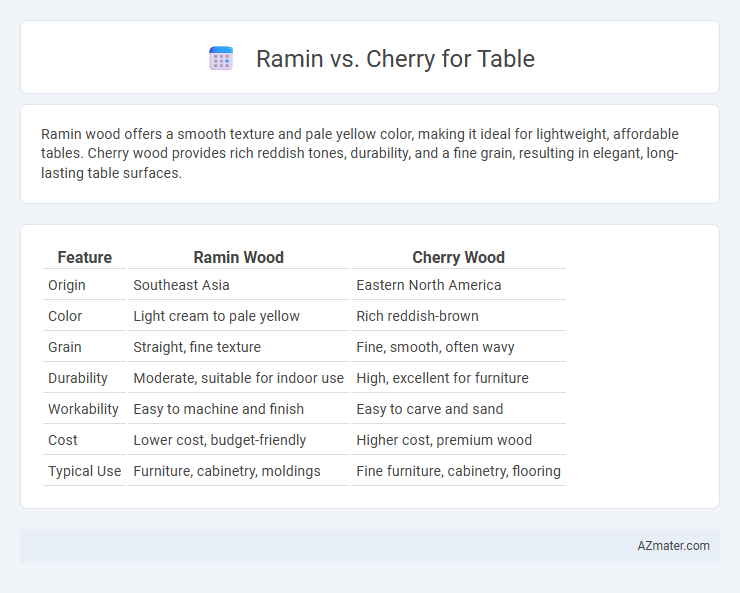Ramin wood offers a smooth texture and pale yellow color, making it ideal for lightweight, affordable tables. Cherry wood provides rich reddish tones, durability, and a fine grain, resulting in elegant, long-lasting table surfaces.
Table of Comparison
| Feature | Ramin Wood | Cherry Wood |
|---|---|---|
| Origin | Southeast Asia | Eastern North America |
| Color | Light cream to pale yellow | Rich reddish-brown |
| Grain | Straight, fine texture | Fine, smooth, often wavy |
| Durability | Moderate, suitable for indoor use | High, excellent for furniture |
| Workability | Easy to machine and finish | Easy to carve and sand |
| Cost | Lower cost, budget-friendly | Higher cost, premium wood |
| Typical Use | Furniture, cabinetry, moldings | Fine furniture, cabinetry, flooring |
Introduction: Ramin vs Cherry for Table
Ramin wood, known for its light color and fine texture, offers a smooth surface ideal for crafting elegant tables, while cherry wood is prized for its rich, warm reddish-brown hues and natural aging that deepens its beauty over time. Both woods provide durability suitable for table construction, but cherry's dense grain and natural luster often make it a preferred choice for high-end furniture. Ramin is more affordable and widely available, making it a practical option for budget-conscious projects without sacrificing quality.
Wood Characteristics: Ramin vs Cherry
Ramin wood is lightweight with a pale yellow to light brown color, offering moderate hardness and fine, straight grain that enhances smooth finishes for furniture and tabletops. Cherry wood, known for its rich reddish-brown hue and fine, closed grain, darkens beautifully with age, providing superior hardness and durability for high-end tables. Both woods are popular in woodworking, but Cherry's natural luster and strength make it ideal for premium, long-lasting tabletops compared to the more economical and easily workable Ramin.
Appearance and Color Comparison
Ramin wood exhibits a light, creamy yellow to pale brown color with a smooth, even grain that gives tables a sleek, contemporary look. Cherry wood features a rich, reddish-brown hue that deepens with age, offering a warm and classic aesthetic ideal for traditional and elegant table designs. Both woods provide distinct visual appeal, with Ramin leaning towards subtle brightness and Cherry delivering a richer, more vibrant color palette.
Durability and Hardness Analysis
Ramin wood exhibits significant durability with a Janka hardness rating of approximately 930 lbf, making it resistant to dents and wear in furniture applications. Cherry wood, valued for its fine grain and rich color, has a slightly lower Janka hardness around 950 lbf, but is prone to softer surfaces and more rapid aging under heavy use. Both woods perform well in furniture, though Ramin's density and hardness offer superior resistance to daily abrasion and impact over time.
Workability and Crafting Ease
Ramin wood offers superior workability due to its fine, even texture and consistent grain, making it ideal for intricate table designs and smooth finishes. Cherry wood is favored in crafting for its excellent sanding properties and natural luster, which enhances the table's aesthetic over time through a rich, dark patina. Both woods provide ease of crafting, but Ramin's machinability excels for precision work, while Cherry's responsiveness to hand tools benefits artisans seeking detailed shaping and carving.
Cost and Availability
Ramin wood is generally less expensive than cherry wood, making it a cost-effective option for table construction. Ramin is widely available, sourced primarily from Southeast Asia, which ensures steady supply for furniture manufacturing. Cherry wood tends to be pricier due to its limited availability and slower growth, often sourced from North America and parts of Europe.
Environmental and Sustainability Factors
Ramin wood, sourced primarily from Southeast Asia, faces significant environmental concerns due to overharvesting and illegal logging, contributing to deforestation and habitat loss. Cherry wood, often harvested from sustainably managed North American forests, offers a more environmentally responsible choice with certifications like FSC ensuring sustainable practices. Choosing cherry for tables supports sustainability efforts by promoting responsible forestry and reducing ecological impact compared to the more vulnerable Ramin species.
Maintenance and Care Requirements
Ramin wood requires regular sealing and oiling to maintain its natural color and prevent drying or cracking, while Cherry wood needs less frequent treatment but benefits from occasional waxing to preserve its rich, reddish tone. Both types of wood respond well to gentle cleaning with a soft cloth and mild soap, avoiding harsh chemicals to prevent surface damage. Proper care extends the longevity of Ramin and Cherry tables, maintaining their aesthetic appeal and structural integrity over time.
Best Uses and Design Styles
Ramin wood, prized for its fine grain and light color, excels in intricate furniture designs and traditional craftsmanship, making it ideal for classic or colonial-style tables. Cherry wood offers rich, warm hues that deepen over time, perfect for elegant, high-end table designs and modern or transitional interiors. Both woods provide durability, but Ramin is better suited for detailed carved elements while Cherry enhances smooth, polished surfaces.
Final Verdict: Which Wood is Better for Your Table?
Ramin wood offers a smooth, fine grain and consistent texture ideal for indoor tables, providing durability and an affordable price point. Cherry wood, prized for its rich reddish hue and natural aging that deepens color over time, offers superior hardness and elegance, making it a premium choice for heirloom-quality tables. Choose Ramin for budget-friendly, functional tables and Cherry for a long-lasting, aesthetically refined centerpiece.

Infographic: Ramin vs Cherry for Table
 azmater.com
azmater.com